Juicing isn’t just a trendy health fad—it’s a powerful habit that can transform your well-being. By extracting nutrients directly from fruits and vegetables, juicing delivers a concentrated dose of vitamins, minerals, and antioxidants, helping you boost energy, support immunity, and improve digestion.
Whether you’re aiming to kickstart a morning routine, detox naturally, or simply sneak more greens into your diet, the right juicer can be a game-changer. But with so many models on the market, how do you choose the best juicer for your lifestyle and budget?
In this guide, we’ll help you compare the types of juicers, essential features to look for, and the top models in 2025 to keep your kitchen efficient—and your health thriving.
Choosing the right juicer type is the single most important decision in your juicing journey. While both centrifugal and masticating juicers aim to extract juice from fruits and vegetables, their technology, performance, and results differ significantly.
Let’s dive deeper into each type to help you make the most informed choice based on your health goals, lifestyle, and budget.
How they work:
Centrifugal juicers use a flat, razor-sharp blade that spins at very high speeds (typically 6,000–14,000 RPM). The spinning motion grinds the produce and uses centrifugal force to separate juice from the pulp, which is then expelled into a separate container.
Fast Juicing: Perfect for busy people who need their juice in under 60 seconds.
Lower Cost: These are often the most affordable type, with plenty of options under €100.
Wide Feed Chutes: Many models allow you to feed in whole fruits (like apples) without chopping.
Lightweight and Compact: Easier to store and move around the kitchen.
Nutrient Loss from Heat & Oxidation: The high-speed spinning generates heat and draws in air, which may degrade some enzymes and reduce the juice’s nutritional value.
Foamy Juice: Juices tend to be frothy and separate quickly—meaning they must be consumed right away.
Noisy Operation: These machines can sound like small jet engines—less ideal for early mornings or shared spaces.
Struggles with Greens: Not very efficient with spinach, kale, herbs, and wheatgrass.
Beginners
People on a tight budget
Those who want juice quickly with minimal prep
Users who mainly juice hard fruits and vegetables (carrots, apples, etc.)
How they work:
Masticating juicers (also called cold press or slow juicers) work at low speeds (typically 40–110 RPM). Instead of shredding, they crush and then press fruits and vegetables to extract juice. This gentle process minimizes heat and oxidation, preserving the integrity of nutrients and enzymes.
Higher Juice Yield: Especially effective for leafy greens, soft fruits, and herbs. You’ll use less produce to get more juice.
Longer Shelf Life: Juice can be stored in the fridge for up to 72 hours without significant nutrient loss.
More Nutrients & Enzymes Retained: The low-speed process keeps vitamins, minerals, and antioxidants intact.
Quieter Operation: Much less noise than centrifugal models.
Multifunctionality: Some models also make nut milk, sorbet, baby food, and even pasta.
Slower Juicing: Extraction takes 3–5 times longer than centrifugal models.
More Expensive: Quality masticating juicers usually start at around €180 and can exceed €500.
Smaller Feed Chutes: You’ll need to cut fruits and veggies into smaller pieces, which adds prep time.
Bulky Design: Heavier and larger, which might be a concern for smaller kitchens.
Health enthusiasts, detoxers, and raw food lovers
Anyone focused on nutrient-dense juicing
Those who juice regularly and want to maximize efficiency and savings on produce
People who plan to store juice in advance
| Feature | Centrifugal Juicer | Masticating Juicer |
|---|---|---|
| Speed | Fast (30–60 seconds per serving) | Slow (3–5 minutes per serving) |
| Juice Quality | Moderate (more oxidation, froth) | High (minimal oxidation, longer shelf life) |
| Price Range | €60–€150 | €180–€600+ |
| Best for Greens | Poor efficiency | Excellent efficiency |
| Noise Level | Loud | Quiet |
| Ease of Cleaning | Moderate to easy | Varies by model (some are harder to clean) |
| Shelf Life of Juice | Up to 24 hours | Up to 72 hours |
| Size & Portability | Compact and lightweight | Larger and heavier |
| Extra Functions | Rare | Often multifunctional |
Do I want to juice mainly for health benefits and nutrient retention?
➤ Go for a masticating juicer.
Am I just starting out or juicing casually?
➤ A centrifugal juicer is a budget-friendly and fast option.
Will I be juicing leafy greens like spinach, kale, or wheatgrass?
➤ Only masticating or twin-gear juicers can handle them efficiently.
Is time a concern in my morning routine?
➤ Centrifugal juicers are best for quick, grab-and-go juice.
Am I okay spending more upfront to save on produce over time?
➤ Masticating juicers produce more juice per fruit, saving money in the long run.
Some experienced juicers even own both types: a centrifugal juicer for fast weekday mornings and a masticating model for weekend batches and green-heavy recipes. It all comes down to your routine and goals.
Whether you’re a first-time buyer or upgrading from an older model, choosing the right juicer is more than just picking between centrifugal and masticating. The right combination of features will determine how often you use it, how easy it is to clean, how much juice you get—and how happy you’ll be with your purchase.
Here’s a detailed breakdown of the must-have features and how to evaluate them based on your juicing needs.
Why it matters: If cleaning your juicer takes longer than making the juice, it’ll soon gather dust in your cupboard.
What to look for:
Dishwasher-safe parts: Speeds up cleanup—check if components like the pulp bin, juice container, and auger are top-rack safe.
Fewer detachable parts: Simpler designs are easier to clean.
Included cleaning brush: Especially important for fine mesh filters that trap pulp and fibers.
Smooth plastic or stainless surfaces: Easier to wipe down compared to textured components.
Pro Tip: Check user reviews for “cleaning time” or “easy to clean” mentions—real-world feedback often tells you more than the spec sheet.
Why it matters: Higher juice yield means better value for money and less waste.
What to look for:
Dry pulp output: Squeeze a bit of pulp after juicing. If it’s very wet, the machine isn’t extracting efficiently.
Dual-stage extraction (in masticating models): These machines crush, then press the pulp, maximizing yield.
Independent pulp ejection: This allows continuous juicing without stopping to empty the pulp bin.
Pro Tip: Some brands advertise “up to 30% more juice.” While this varies, masticating juicers generally beat centrifugal models in juice yield—especially with leafy greens and herbs.
Why it matters: If you’re juicing early in the morning or have a baby, thin walls, or noise-sensitive housemates, a quiet juicer is worth it.
What to look for:
RPM (revolutions per minute): Lower RPM = quieter operation.
Decibel rating (if provided): Under 60 dB is considered quiet. Many masticating juicers fall in this range.
User reviews: Look for terms like “quiet” or “surprisingly loud” to get a feel for real usage.
Pro Tip: Centrifugal juicers tend to be the loudest. Choose a masticating model if silence is golden in your home.
Why it matters: A wide feed chute means less prep time—no need to chop fruits and vegetables into tiny bits.
What to look for:
Extra-wide chute (over 70mm): Can accommodate whole apples and carrots.
Tilted or angled feed chutes: Helps guide produce into the juicing chamber smoothly.
Safety design: Look for models with child-safe chutes that prevent fingers from reaching the blades or augers.
Pro Tip: While wider is often better, make sure the chute size doesn’t compromise the machine’s ability to grip and crush produce effectively (especially for leafy greens).
Why it matters: A high-quality juicer is an investment. Durable materials mean better longevity and safer juicing.
What to look for:
Stainless steel blades and strainers: More durable than plastic and won’t dull quickly.
BPA-free plastic components: Important if you care about food safety.
Augers made from Ultem or Tritan plastic: Extra-strong and resistant to cracking.
Heavy base and non-slip feet: For safe, stable operation even with hard produce.
Pro Tip: Consider brands with a reputation for build quality—Omega, Breville, Hurom, and Tribest all offer sturdy machines built to last.
Why it matters: You’ll use your juicer more if it fits easily into your kitchen setup.
What to look for:
Vertical vs. horizontal design: Vertical juicers save counter space; horizontal models tend to be bulkier but are often multifunctional.
Cord storage and handles: Make it easier to put away after use.
Weight: If you plan to move it often, go for a lighter model (under 5 kg).
Pro Tip: Measure the space on your countertop and under your cabinets to ensure your new juicer fits comfortably.
Why it matters: Different fruits and vegetables require different speeds for optimal juicing.
What to look for:
Multiple speed settings: Centrifugal models with 2+ speeds allow you to adjust for soft vs. hard produce.
Reverse function (in masticating juicers): Helps unclog stuck produce and reduces jamming.
Pulse function: Good for clearing out leftover pulp at the end of juicing.
Pro Tip: While masticating juicers typically have a single low-speed mode, models with a reverse button or overload protection can save time and frustration.
Why it matters: Juicers are mechanical devices—and like all appliances, they can wear down or break over time.
What to look for:
Warranty length: Most centrifugal models come with 1–2 years; premium masticating juicers often offer 5–15 years on the motor.
Customer service quality: Check reviews about support responsiveness.
Spare parts availability: Choose brands that offer replacement parts like filters, augers, and seals.
Pro Tip: A longer warranty often reflects better overall quality—and peace of mind if something goes wrong.
Why it matters: Some masticating juicers go beyond juice, helping you make:
Nut butters
Almond or oat milk
Sorbets
Pasta
Baby food
What to look for:
Included attachments or optional add-ons
Clear instructions for non-juicing uses
Pro Tip: These features are great if you like experimenting in the kitchen—but may not be worth the price hike if you only want juice.
For convenience and daily use → Prioritize easy cleaning, noise level, and chute size.
For maximum nutrition and long-term value → Focus on juice yield, build quality, and warranty.
For budget-conscious shoppers → Look for essential features in a simplified design with solid user reviews.
In 2025, the juicer market is more innovative and competitive than ever. Whether you’re a green juice devotee, a citrus lover, or a smoothie experimenter, there’s a perfect model out there for you. Below is a handpicked selection of the most reliable, high-performance juicers that have gained the trust of health-conscious users worldwide.
Each of these juicers has been evaluated based on performance, juice quality, ease of use, durability, and user satisfaction. Let’s break down what makes each one shine.
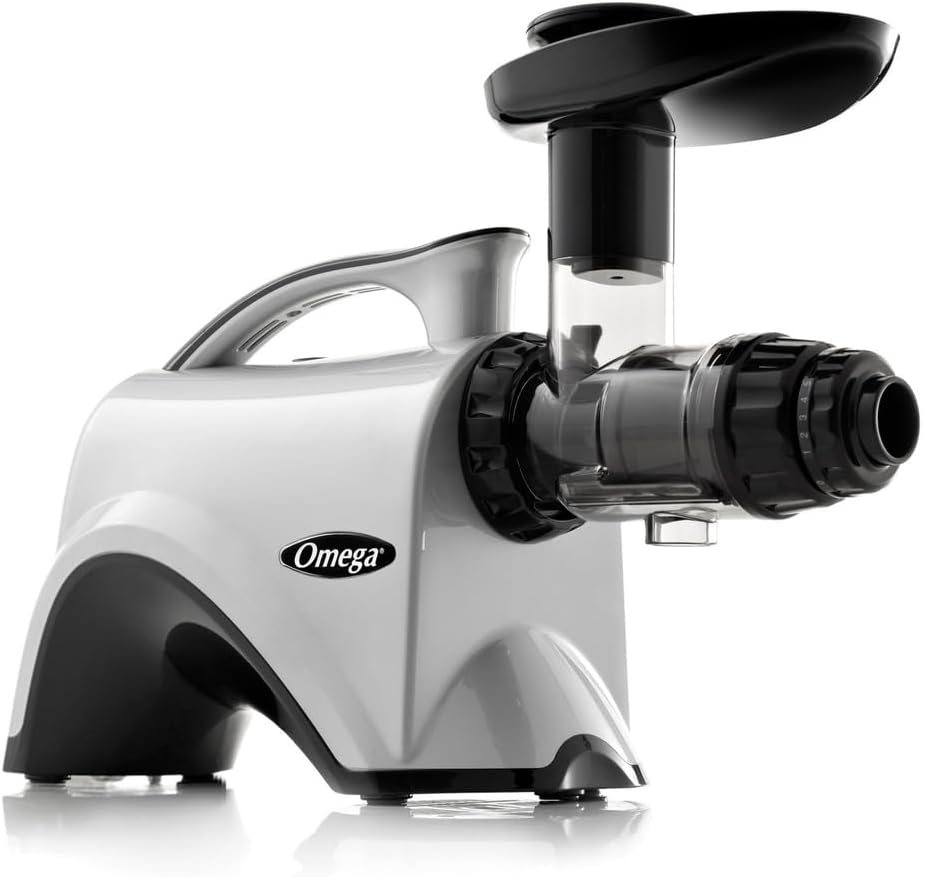
Best Overall for Versatility and Juice Quality
The Omega NC1002HDS is a standout masticating juicer that excels in just about every category. It operates at a low speed of 80 RPM, preserving essential enzymes and nutrients while minimizing oxidation. The slow, dual-stage extraction process ensures maximum juice yield and dry pulp.
What makes it special:
Exceptional at juicing leafy greens like spinach, kale, wheatgrass, and herbs.
Works equally well with hard vegetables (carrots, beets) and soft fruits (berries, grapes).
Functions as a complete nutrition center: can make nut butters, frozen desserts, soy milk, and even extrude pasta.
Long-lasting, powerful motor that handles daily juicing with ease.
Includes a reverse function to prevent clogging, plus automatic pulp ejection for continuous juicing.
Best for: Serious juicers, families, and anyone looking to juice a wide variety of produce with maximum nutrient retention.
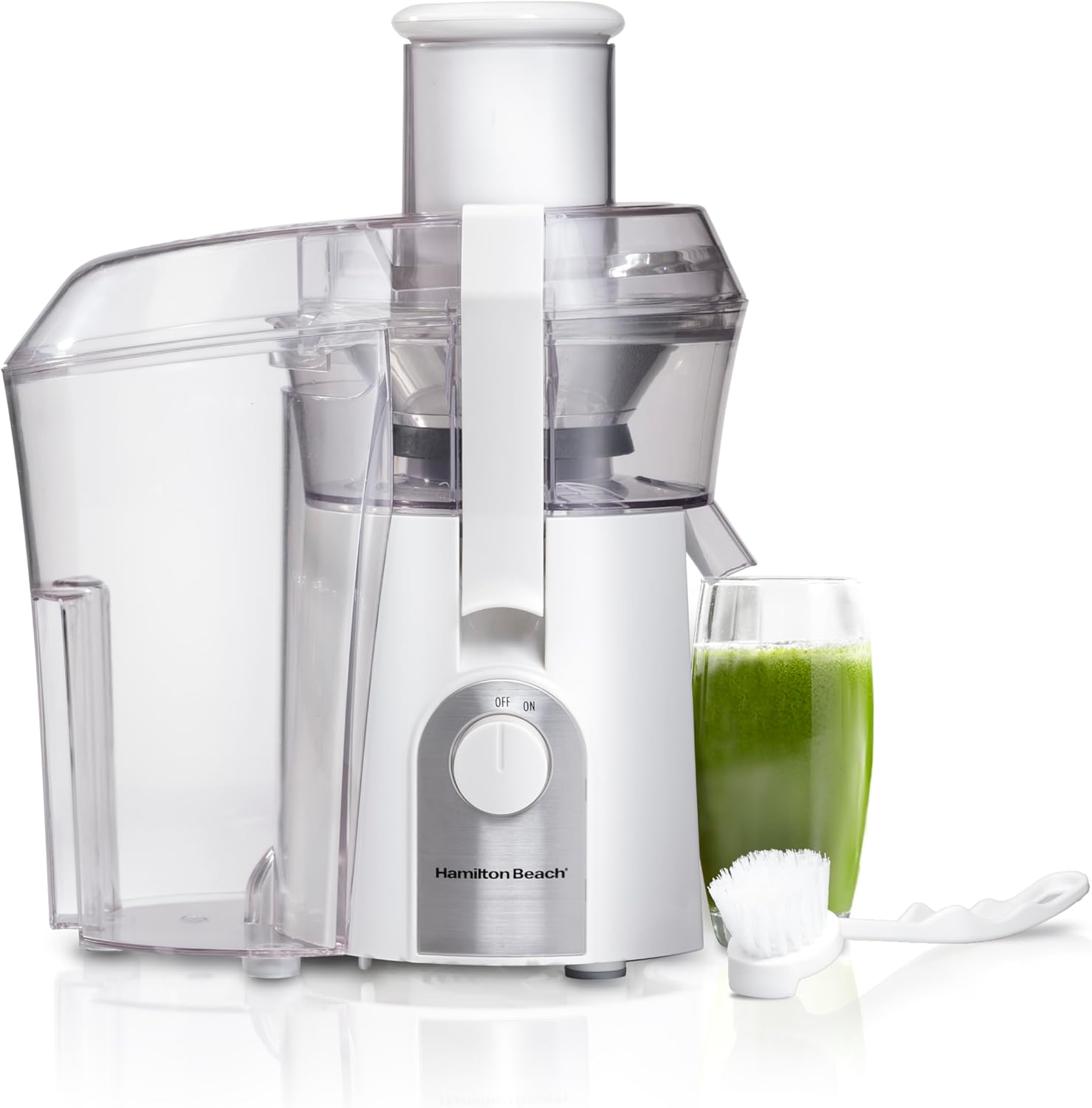
Best for Beginners and Fast Juicing
This centrifugal juicer is a fantastic entry point for those who are just starting their juicing journey. It’s incredibly easy to use, with a wide mouth that allows you to juice whole fruits and vegetables—saving you time on prep.
What makes it special:
Extra-wide 3-inch chute fits whole apples, carrots, and more—no chopping required.
Powerful motor quickly extracts juice from firm fruits and vegetables.
Large pulp container allows you to juice continuously without frequent stops.
Minimal parts make assembly and cleanup fast and straightforward.
Compact design fits well in smaller kitchens or limited counter space.
Best for: Busy users who want quick results and a user-friendly design without a steep learning curve.
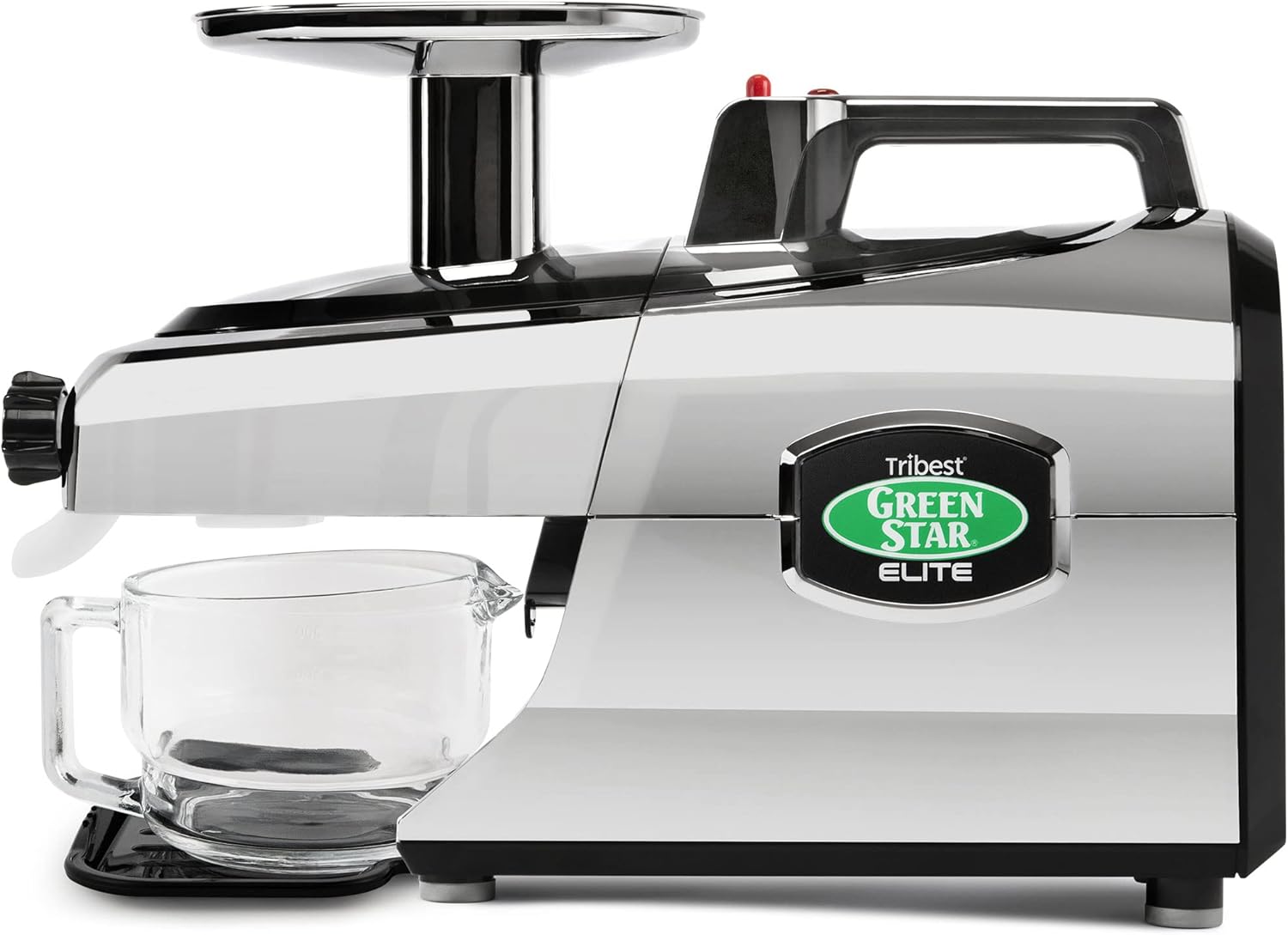
Best for Nutrient-Dense Juicing and Leafy Greens
The Tribest Greenstar Elite is a professional-grade twin gear juicer that uses bioceramic and magnetic technology to preserve nutrients at a cellular level. It’s particularly effective for those on detox plans or plant-based diets who rely on daily juicing for nutrition.
What makes it special:
Twin gear extraction crushes and presses produce more thoroughly than single auger models.
Exceptional juice yield from leafy greens, wheatgrass, and fibrous vegetables.
Juice stays fresher for longer due to low oxidation and heat.
Solid, well-engineered build designed for daily, long-term use.
Can also make sorbets, nut butters, breadsticks, and sauces with optional attachments.
Best for: Raw food enthusiasts, juice cleansers, and anyone who prioritizes maximum nutrition and long-lasting juice.
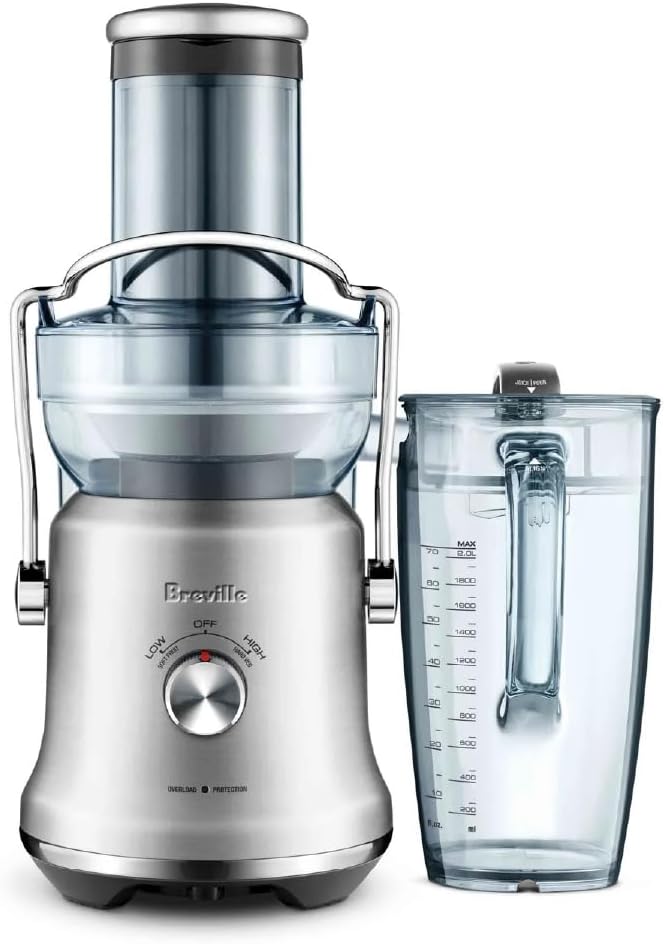
Best Centrifugal Juicer for Convenience and Technology
This high-end centrifugal juicer introduces cold spin technology, allowing juice to flow through a stainless steel cutting disc surrounded by a mesh filter—minimizing heat transfer and preserving more nutrients than traditional centrifugal models.
What makes it special:
Cold spin tech makes it unique among centrifugal juicers, combining speed with decent nutrient preservation.
Large capacity juice jug and pulp bin ideal for making juice in batches.
Extra-wide feed chute minimizes prep time—great for those always in a rush.
Dual-speed control for adjusting power based on produce firmness.
Sleek design with high-end finishes looks great on any kitchen counter.
Best for: Users who want fast juicing but also care about keeping more nutrients intact.
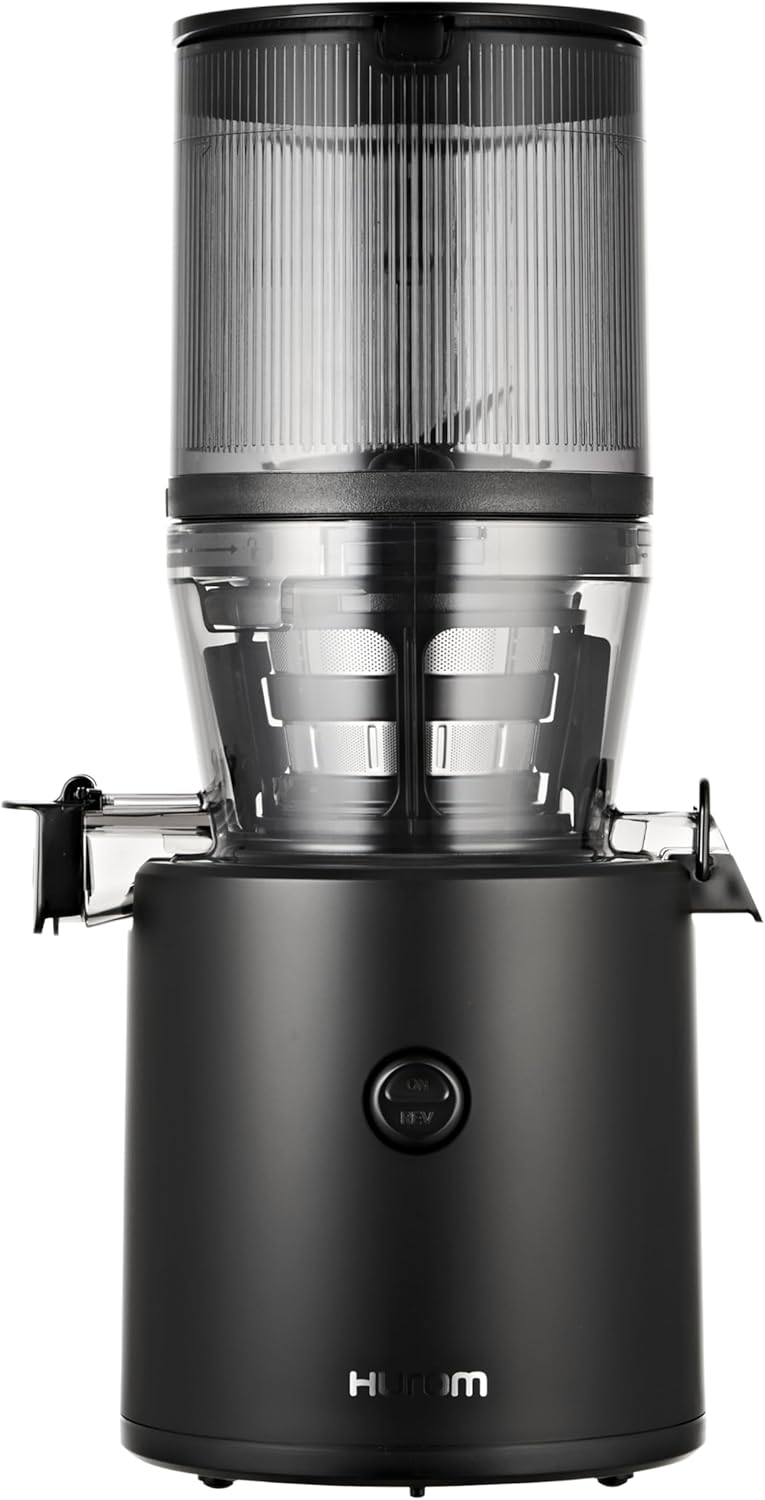
Best for Compact Spaces and Quiet Juicing
The Hurom HP is a vertical, single-auger masticating juicer designed with modern kitchens in mind. It’s compact, stylish, and surprisingly powerful, despite its small footprint.
What makes it special:
Vertical design saves space without sacrificing performance.
Quiet motor makes it one of the least disruptive juicers on the market—perfect for early mornings.
Delivers excellent juice yield from a variety of produce, including greens and fruits.
Pulp control lever lets you adjust the thickness and texture of your juice.
Safety features include a slow start and anti-jam function, making it ideal for new users.
Best for: Apartment dwellers, couples, or anyone seeking a minimalist, quiet, and efficient juicing solution.
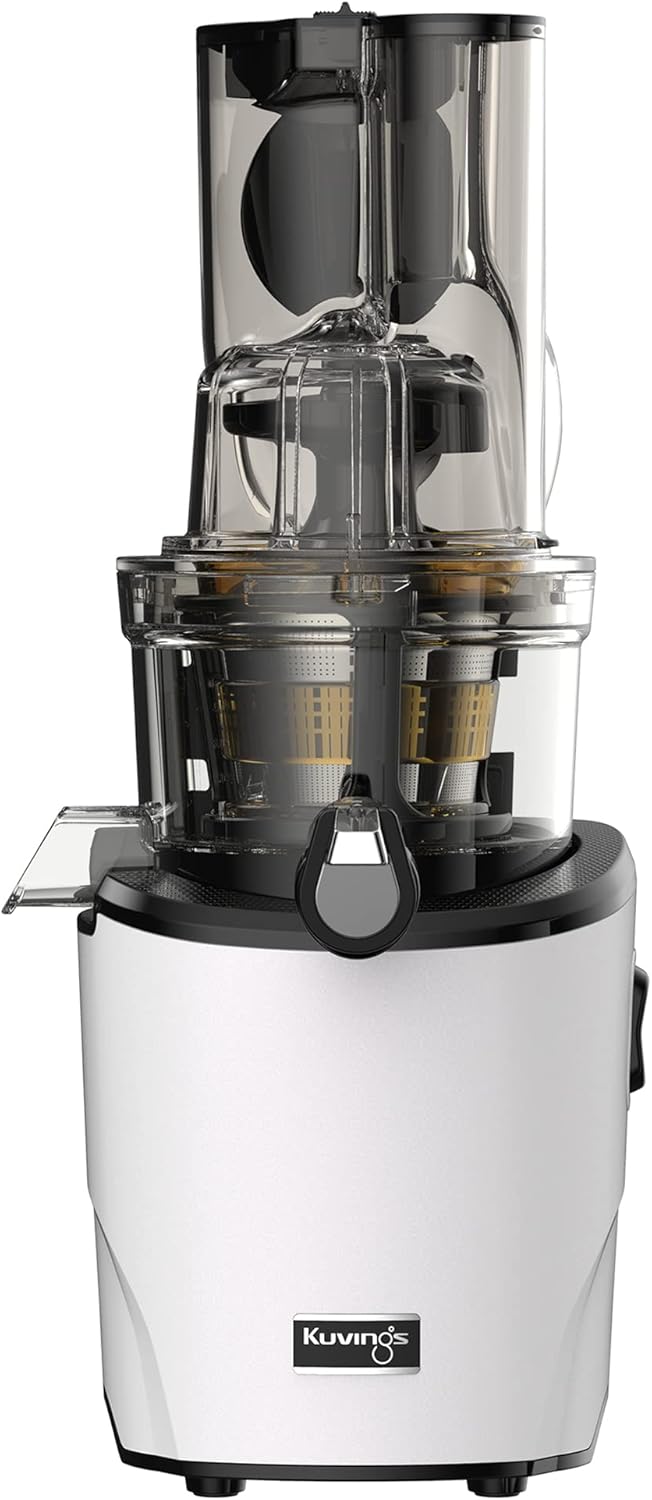
Best for Batch Juicing and Whole Fruits
Kuvings is known for innovation, and the EVO820 model lives up to its reputation. With its 82mm wide feed chute, it can handle whole apples, oranges, and larger chunks of produce, making prep minimal.
What makes it special:
Slow-speed masticating process (50 RPM) preserves maximum nutrients and flavor.
Patented flip gate system makes it safer to use while reducing chances of clogging.
Comes with multiple strainers for juice, smoothies, and sorbet.
Sleek leather-patterned body and chrome accents give it a premium aesthetic.
Includes a smart cap for easy juice mixing and drip-free pouring.
Best for: Juice lovers who want premium build quality, batch preparation, and the ability to process large fruits with minimal chopping.
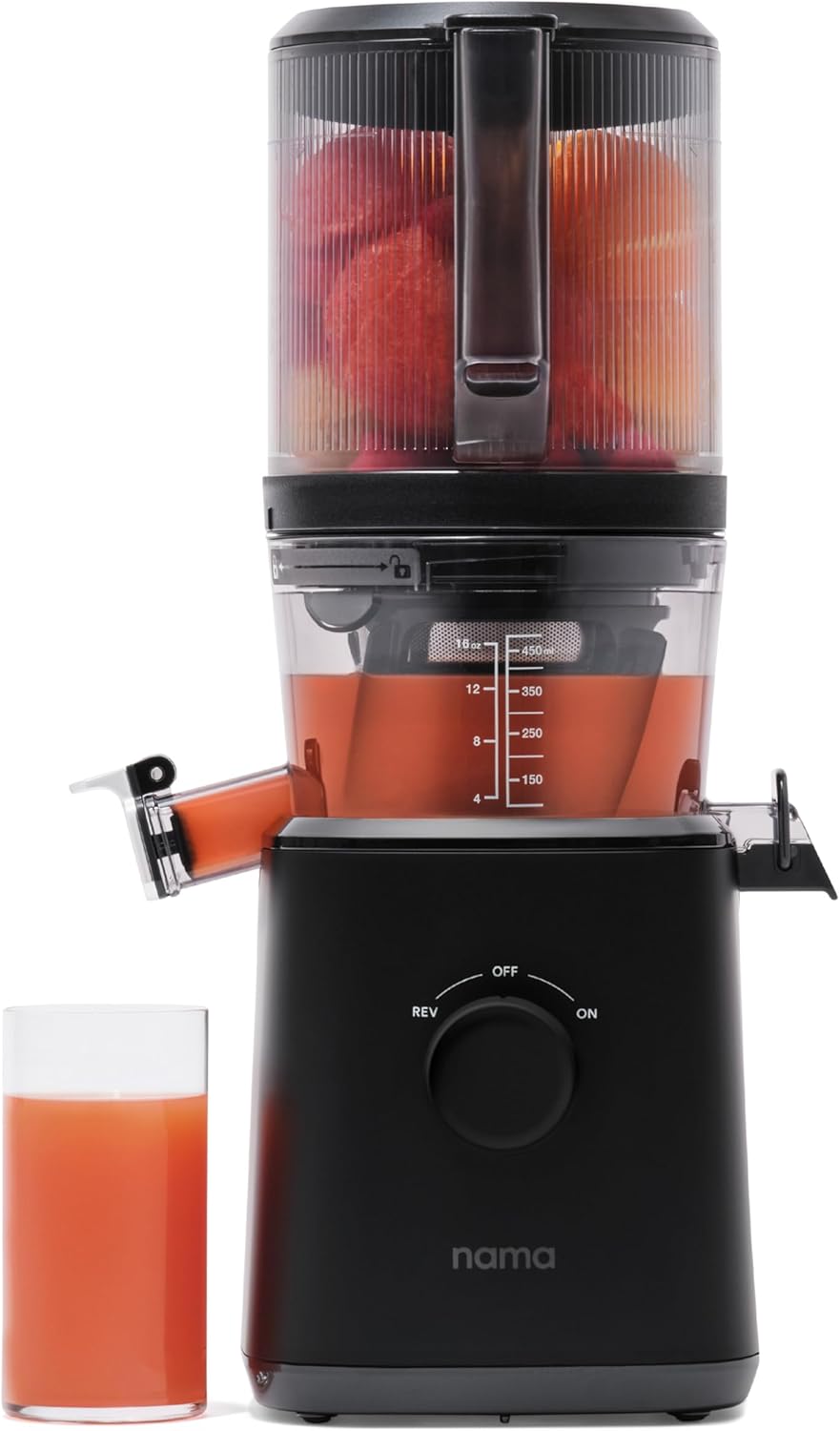
Best for Hands-Free Juicing and Automation
One of the most innovative models in recent years, the Nama J2 allows you to load all your produce into a large container at once. The machine then automatically feeds items into the auger—freeing up your hands during the process.
What makes it special:
Auto-feeding chamber allows you to “set it and forget it.”
High juice yield with very dry pulp.
Quiet operation makes it suitable for early mornings or family use.
Designed by the creators of the original Hurom juicers, ensuring high build quality.
Ideal for those who juice in bulk and want less hands-on time.
Best for: Busy professionals, parents, or anyone who wants maximum convenience with minimal effort.
Each of these juicers excels in different ways—some are built for speed, others for nutrition, and a few for ease of use or space-saving design. Here’s a quick overview:
Omega NC1002HDS → Best all-rounder with multifunction features.
Hamilton Beach 67601 → Best for budget-friendly, fast juicing.
Tribest Greenstar Elite → Best for serious health enthusiasts focused on greens.
Breville Cold Plus → Best centrifugal model with advanced features.
Hurom HP → Best compact, quiet, and stylish juicer.
Kuvings EVO820 → Best for minimal prep and premium aesthetics.
Nama J2 → Best for hands-free, automatic juicing.
Juicing should be a joy, not a chore. But to truly stick with the habit, two things need to happen: your juice must taste amazing, and your juicer must be easy to clean.
In this section, you’ll find:
Tried-and-true juice recipes for energy, immunity, detox, and flavor.
Storage tips to keep your juice fresh.
Smart cleaning hacks that save time and effort (and prevent dreaded pulp buildup).
These recipes are beginner-friendly, quick to make, and don’t require fancy or hard-to-find ingredients. Each one is designed to support a specific goal—whether it’s boosting energy, fighting colds, or helping digestion.
Perfect for flushing out toxins and boosting hydration.
Ingredients:
1 cucumber
2 celery stalks
1 green apple
Juice of ½ lemon
A handful of spinach
Small piece of ginger (optional)
Benefits: High in chlorophyll, hydration, and antioxidants. A great morning reset.
Bright, zesty, and great for kickstarting your day.
Ingredients:
2 oranges (peeled)
2 carrots
1 small apple
1-inch piece of ginger
Benefits: Rich in vitamin C, beta-carotene, and anti-inflammatory properties. Ginger adds a warming touch.
A nutrient-dense juice that’s sweet, earthy, and energizing.
Ingredients:
1 medium beet (peeled)
2 carrots
1 apple
Juice of ½ lemon
Benefits: Supports cardiovascular health and circulation. Beets are great for natural stamina.
Great as a concentrated health boost during cold and flu season.
Ingredients:
1 lemon
1 orange
½-inch piece of turmeric root
½-inch piece of ginger
Pinch of black pepper (boosts turmeric absorption)
Benefits: High in vitamin C and antioxidants; turmeric and ginger offer powerful anti-inflammatory effects.
Loaded with vibrant fruits for anti-aging and immune defense.
Ingredients:
1 cup blueberries
1 handful of red grapes
½ pomegranate (seeds only)
1 apple
Benefits: Packed with antioxidants, polyphenols, and natural sweetness. A treat for your taste buds and your cells.
If you’re using a masticating or cold press juicer, you can make juice in batches and store it. Here’s how to do it right:
Use airtight glass containers: Mason jars or vacuum-sealed bottles work best.
Fill to the top: Less air means less oxidation.
Refrigerate immediately: Keep juice as cold as possible to retain nutrients.
Consume within 72 hours: While cold-pressed juice lasts longer, it’s always best to drink it fresh.
Tip: Add a few drops of lemon juice to slow oxidation, especially in green juices.
Cleaning your juicer doesn’t have to be tedious. A clean machine not only works better but also ensures your juice tastes fresh and free of old residue or mold.
Here’s how to make cleanup simple:
Do this right after use to prevent pulp from drying:
Disassemble the juicer immediately after use.
Rinse all removable parts under warm running water.
Use the included cleaning brush to scrub the strainer and mesh filter.
Wipe down the motor base with a damp cloth—never submerge the base.
Why it works: The sooner you rinse, the less you scrub. Dried pulp is your enemy.
Prevents buildup and keeps your juicer smelling fresh.
Soak all removable parts in warm water with white vinegar (or lemon juice) for 10–15 minutes.
Scrub gently with a soft brush or sponge.
Use a toothbrush or bottle brush to clean tight spaces and spouts.
Rinse thoroughly and let air dry completely before reassembling.
Pro Tip: If your juicer’s filter basket has fine mesh, sprinkle baking soda on a damp brush to help scrub away dried pulp or stains.
Don’t use harsh dish soap or abrasive sponges—these can damage plastic parts and leave a chemical taste.
Avoid leaving pulp overnight. Even one missed cleaning can create a tough film and unpleasant odors.
Never put non-dishwasher-safe parts in the dishwasher. It can warp plastic or damage seals.
Bottle brushes: For tight spouts and corners
Silicone scrubbers: Gentle on plastic but great for grime
Mini vacuums or handheld dust blowers: To clean pulp buildup in vents or crevices (especially in masticating juicers)
Juice softer fruits last—they help flush out fibrous pulp.
Run a glass of water through the juicer after your last ingredient to pre-clean the system.
Keep your cleaning brush right next to your sink—so you’re always ready for a quick rinse.
Choosing the right juicer doesn’t have to be overwhelming. Whether you prioritize speed, nutrition, or ease of use, there’s a perfect match for your lifestyle. By understanding the differences between centrifugal and masticating juicers, focusing on key features, and exploring top-rated models, you’re now equipped to make a confident, informed decision.
| Cookie | Duration | Description |
|---|---|---|
| cookielawinfo-checbox-analytics | 11 months | This cookie is set by GDPR Cookie Consent plugin. The cookie is used to store the user consent for the cookies in the category "Analytics". |
| cookielawinfo-checbox-functional | 11 months | The cookie is set by GDPR cookie consent to record the user consent for the cookies in the category "Functional". |
| cookielawinfo-checbox-others | 11 months | This cookie is set by GDPR Cookie Consent plugin. The cookie is used to store the user consent for the cookies in the category "Other. |
| cookielawinfo-checkbox-necessary | 11 months | This cookie is set by GDPR Cookie Consent plugin. The cookies is used to store the user consent for the cookies in the category "Necessary". |
| cookielawinfo-checkbox-performance | 11 months | This cookie is set by GDPR Cookie Consent plugin. The cookie is used to store the user consent for the cookies in the category "Performance". |
| viewed_cookie_policy | 11 months | The cookie is set by the GDPR Cookie Consent plugin and is used to store whether or not user has consented to the use of cookies. It does not store any personal data. |